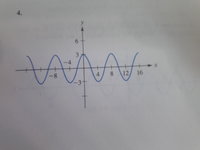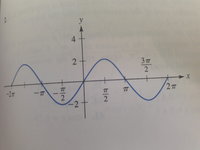You are using an out of date browser. It may not display this or other websites correctly.
You should upgrade or use an alternative browser.
You should upgrade or use an alternative browser.
Find Period of Trig Functions
- Thread starter harpazo
- Start date
harpazo
Full Member
- Joined
- Jan 31, 2013
- Messages
- 891
harpazo
Full Member
- Joined
- Jan 31, 2013
- Messages
- 891
Oh, from the graph. You find one full period of the graph and subtract the x-valus from the start and finish of that period. Take the absolute value of that difference.
Can you please show me what you mean using the graph below. I will then return to the textbook to solve similar problems following your steps here.

Harry_the_cat
Elite Member
- Joined
- Mar 16, 2016
- Messages
- 3,755
See (0,0) is on the graph. After one full cycle, or S shape, we get to the point (2pi,0).
What distance is that on the x-axis? 2pi. So the period is 2pi.
Harry_the_cat
Elite Member
- Joined
- Mar 16, 2016
- Messages
- 3,755
On this one, I'd look at (0, 3) and (8, 3). That's a full cycle so period is 8.Can you please show me what you mean using the graph below. I will then return to the textbook to solve similar problems following your steps here.
View attachment 19115
It doesnt matter what two points you look at, as long as there is a full cycle between them. For example, (4, -3) and (12,-3). Period is still 8.
Steven G
Elite Member
- Joined
- Dec 30, 2014
- Messages
- 14,559
One period starts at 0 and finishes at 8. Another period/cycle starts at 4 and finishes at 12. Another one starts at starts at -4 and finishes at 4. Just take any of those and subtract the end values. For example 8-0 = 8, 12-4 = 8, 4-(-4) = 8. The length of the period is 8.Can you please show me what you mean using the graph below. I will then return to the textbook to solve similar problems following your steps here.
View attachment 19115
harpazo
Full Member
- Joined
- Jan 31, 2013
- Messages
- 891
See (0,0) is on the graph. After one full cycle, or S shape, we get to the point (2pi,0).
What distance is that on the x-axis? 2pi. So the period is 2pi.
I totally get it. Use the distance formula for points. Thanks.
harpazo
Full Member
- Joined
- Jan 31, 2013
- Messages
- 891
One period starts at 0 and finishes at 8. Another period/cycle starts at 4 and finishes at 12. Another one starts at starts at -4 and finishes at 4. Just take any of those and subtract the end values. For example 8-0 = 8, 12-4 = 8, 4-(-4) = 8. The length of the period is 8.
Very good. Thanks.
Dr.Peterson
Elite Member
- Joined
- Nov 12, 2017
- Messages
- 16,605
Just add [MATH]2\pi[/MATH] for each cycle.
If each block in a city is 900 feet, then the first ends after 900, the second after 1800, the third after 2700, and so on. And in Trig City, every block looks exactly the same.
If each block in a city is 900 feet, then the first ends after 900, the second after 1800, the third after 2700, and so on. And in Trig City, every block looks exactly the same.
harpazo
Full Member
- Joined
- Jan 31, 2013
- Messages
- 891
Just add [MATH]2\pi[/MATH] for each cycle.
If each block in a city is 900 feet, then the first ends after 900, the second after 1800, the third after 2700, and so on. And in Trig City, every block looks exactly the same.
Thanks. Will do.

